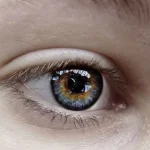Summary: Computer Vision Syndrome (CVS) results from prolonged screen use, causing eye strain, headaches, blurred vision, dry or irritated eyes, and neck pain. Factors like screen glare, improper lighting, and constant air flow worsen symptoms. To reduce the impact, adjust ambient light, minimise glare, maintain proper monitor distance (20–28 inches), and follow the 20‑20‑20 rule (look 20 feet away every 20 minutes). Also, tweak device settings, blink often, use artificial tears if needed, and consult an eye doctor for screen‑specific eyewear.
|
Key Takeaways:
|
Computers are an integral part of life today, and one cannot imagine their lives without computers. They are inevitable at every step of life and have made our world a small global village. However, with digitalisation and a steep increase in our screen time, we have started to strain our eyes daily for hours on the computers, leading to several problems – one of them is Computer Vision Syndrome.
Computer Vision Syndrome (CVS) is an ocular condition that arises from focusing the eyes on a computer or other display devices for long and uninterrupted periods. As a result, the eye muscles are unable to recover from the constant tension required to maintain focus on a close object.
A few common CVS symptoms include headaches, blurred vision, neck pain, eye fatigue, eye strain, dry eyes, irritated eyes, double vision, vertigo/dizziness, polyopia, difficulty in refocusing the eyes, etc. These symptoms are often aggravated by improper lighting conditions (i.e., glare, strong blue-spectrum backlights, or bright overhead lighting). Even the air moving past the eyes (e.g., overhead vents, direct air from a fan) contributes to it. As per experts, CVS is similar to carpal tunnel syndrome and other repetitive motion injuries that people might experience at work. It happens because the human eyes follow the same path over and over. Eye specialists are of the view that CVS can get worse as a result of continued movement.
Eye Care Tips to Manage Computer Vision Syndrome
Cut the glare:
Changing the lighting around you to reduce your computer screen’s effect can be helpful. For instance, if the light from a nearby window casts a glare, moving your monitor may help, and so can the closing of the shades. Installing a dimmer switch for the overhead fixtures if they’re too bright might help too. It is also advisable to use a desk lamp with a moveable shade that casts light evenly over the desk. Finally, adding a glare filter to the device monitor can also help deal with the ocular disease.
Rearrange the desk:
As per experts, the best position for the monitor is slightly below the eye level, i.e., about 20 to 28 inches away from the face. In an ideal situation, you shouldn’t stretch your neck or strain your eyes to see what’s on the screen since one of the most significant issues of straining arises while typing. To lessen this, it is advisable to put a stand next to the monitor. By doing this, you won’t have to look up at the screen and back down at the desk while you type.
Giving your eyes a break:
Like all other organs, your eyes too need a break. Follow the 20-20-20 rule, which means look away from the screen every 20 minutes and look at something that is placed 20 feet away for about 20 seconds. It is advised to blink often to keep the eyes moist. In case of dryness, it is advisable to use eye drops.
Tweak the device settings:
While the factory-installed presets are easy to use, one should remember that they can change them if found to be uncomfortable and adjust factors like brightness, contrast, and font size until the best fit is found.
Apart from this, make sure to regularly visit an eye doctor for exams and keep the prescriptions up to date. An eye expert should be aware of any problems patients might be suffering from. You never know you might need glasses or contact lenses; only your eye doctor can decide if you need to wear regular glasses for computer work or if they need a unique pair for working on a computer. They might prescribe a single or bifocal lens along with tinted lens material to enhance contrast and filter out glare.
Several computer and smartphone applications, such as redshift and Night Shift, adjust the computer video colour temperature, reducing the amount of blue light emitted by the screen, particularly at night.
CVS becomes worse at night. Hence, it is recommended to use a dark user interface while working at night on the computer. Several browsers and OS add-ons exist to darken the user interface.
With proper care, Computer Vision Syndrome can be dealt with ease and does not pose many problems.
Why should you choose us for a successful Computer Vision Syndrome treatment?
At Centre for Sight, our experts perform comprehensive eye tests to chalk out eye problems. With the use of the latest technology and years of experience, our doctors provide end-to-end treatment for computer vision syndrome, including the detection, evaluation, and management of every individual before customising the best possible treatment protocol for computer vision syndrome.





